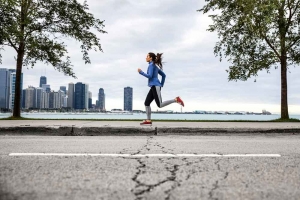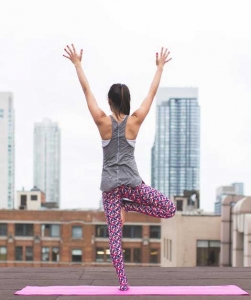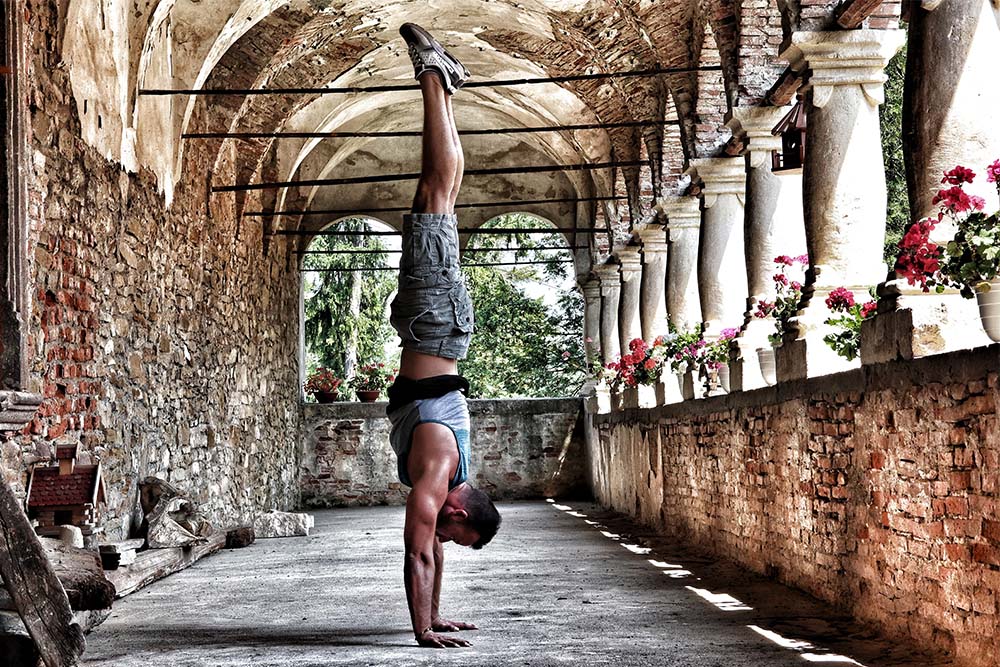For as long as I can remember, people have been exercising outside. Whether it is going for a run, taking a nice long bike ride, or even doing tai chi in the park – the specifics do not matter.
All that matters is that people are getting outside in the sunshine and exercising.
However, over the last few years we have seen civilization rise to new heights. The rate of urbanization has increased exponentially, and with it has come an associated increase in poor air quality and pollution.
But is this something you need to be worrying about?
How COVID is forcing people to work out outside
Most people who are into this whole ‘exercise’ thing tend to spend most of their training time indoors. This means gym sessions, yoga classes, group functional fitness classes, Pilates, and pretty much everything in between.
In fact, only a small subset of the exercising population consistently exercises outdoors.
But this has recently changed.
Since the rise of COVID-19 we have seen a myriad of restrictions put in place across the globe. These have included social distancing requirements, the removal of group exercise sessions, and even complete gym shutdowns – all of which has caused a significant increase in the number of people exercising outdoors [1].
Which means that air pollution is something we now need to consider.
Related Article: How to Set Health Goals After COVID-19
Dangers of poor air quality
The reason researchers across the globe are becoming increasingly concerned about air pollution comes down to the fact that it has been linked to numerous negative health effects [2].
In fact, even shorts term exposure to air pollutants has been shown to increase your risk of developing respiratory problems such as coughing, shortness of breath, an inability to breath clearly, wheezing, and even hospitalization.
Medium term exposure can lead to the development of more serious respiratory diseases such as Chronic Obstructive Pulmonary Disease (or COPD for short) and asthma.
Finally, the long-term effects of exposure to air pollution can include pulmonary insufficiency, cardiovascular disease, diabetes, and even shorter lifespan. Scarily, some research has even indicated that air pollution may be linked to diabetes, depression, and anxiety.
In short, air pollution can have some serious effects on your health.
Where is the poorest air quality?
It is well established that most of the pollutants found in the air are the result of large-scale human interventions, such as the industrial machinery, power stations, combustion engines, and petrol based transportation.
And of these, it appears that cars are the biggest contributor, in which they are believed to be responsible for about 80% of the worlds air pollution [3].
It is also important to note that there are other factors that contribute to air pollution, albeit to a lesser degree. These include certain field cultivation techniques (i.e., herbicide and pesticide use), fuel tanks heaters, and cleaning products.
As such, air pollution predominantly affects those living in large urban areas with extreme transport emissions. This is worse in developing countries, where overpopulation and uncontrolled urbanization leads to severe reductions in air quality, especially in locations where there are obvious social disparities and a lack of information regarding the sustainable management of the environment.
Does exercising in polluted areas still provide benefits?
There is no question that exercise is good for you.
A single bout of exercise has been shown to improve mood and enhance cognitive function, while long term exercise can improve fitness, stave off diabetes, heart disease, mental health disorders, age related declines in function, and even protect against certain cancers.
In short, it is a panacea.
However, given that air pollution has numerous negative effects on health, you have to wonder if the cost outweighs the benefits… and fortunately, there is a significant body of research that has set out to answer that specific question [4].
Evidence suggests that exercising in air polluted areas can still cause improvements in cardiovascular health, cardiopulmonary function, and fitness. However, this can come with some declines in both pulmonary function and immune system health.
While it has not been extensively explored, it is likely that exercising in air polluted areas will also come with improvement in mental health and emotional wellbeing – which is a big positive.
It is also important to note that the benefits observed are generally going to be less if you are exercising in an area with high air pollution compared to an area of low pollution.
Finally, there also appears to be a dose response relationship regarding air pollution and exercise [5]. This means that the longer you are exposed to polluted air, the worse it is for your health. Similarly, if the air quality is particularly bad, then the negative impacts on your health occur faster.
Study
For example, a recent study explored the implications of exercising in areas of mild air pollution compared to heavy air pollution – and the results were confronting to say the least.
They found that people who exercise outdoors in “cleaner” cities (i.e., less air pollution) saw benefits to their health even when they exercised all the way up to 90 minutes at a time, suggesting that the benefits of exercise markedly outweighed the negative health effects of the air pollution.
However, for those in the cities with the worst air quality, exposing themselves to polluted air seemed to cancel out the health benefits of exercise after 15 minutes per bout. Moreover, the health risks associated with the air pollution surpassed the exercise benefits after 75 min of exercise outdoors.
All of which indicates that the being conscious of your air quality is incredibly important.
When not to work out
Something we really want to hammer home is that while exercise generally has a net positive effect on health (unless you exercise for too long in some of the most polluted cities in the world), there are times when you should skip it altogether.
First and foremost, if you live in a city, there will be times when a traffic incident causes a traffic jam. This can lead to huge declines in air quality due to the accumulation of transport fumes.
Exercise here should be avoided.
Secondly, during bushfire season there are times when the smoke can become incredibly dangerous to your health. As obvious as it may sound, exercising outdoors – and simply going outdoors – should be avoided at all costs [6].
These two examples are some of the more common ones, and should give you some insight into what should be avoided regarding outdoor exercise.
How to check air quality in your area
OK, so all this information about air quality is all well and good, but how do you know how polluted the area is?
Well, fortunately it is easy to find out.
The quality of the air in your area is measured using what is known as the ‘air quality index’. This is a tool used by government agencies across the globe to inform the public as to how polluted the air currently is, or how polluted it is going to be over the coming days.
Air Quality Index
In essence, this index gives you ranking with reference to the air quality of your area:
- Good (a score of 1–50) means you enjoy your usual outdoor activities. This is the ideal air quality.
- Moderate (a score of 51-100) means that the air quality is acceptable; however, there may be a moderate health concern for a very small number of people who are unusually sensitive to air pollution. Active children and adults, and people with respiratory disease, such as asthma, should limit prolonged outdoor exertion.
- Unhealthy for sensitive groups (a score of 101–150) means that members of sensitive groups may experience health effects. The general public is not likely to be affected. However, active children and adults, and people with respiratory disease, such as asthma, should limit prolonged outdoor exertion.
- Unhealthy (a score of 151-200) Means that everyone may begin to experience health effects; members of sensitive groups may experience more serious health effects. Active children and adults, and people with respiratory disease, such as asthma, should avoid prolonged outdoor exertion; everyone else, especially children, should limit prolonged outdoor exertion.
- Very Unhealthy (a score of 201-300) indicates health warnings of emergency conditions. The entire population is more likely to be affected. Active children and adults, and people with respiratory disease, such as asthma, should avoid all outdoor exertion; everyone else, especially children, should limit outdoor exertion.
- Hazardous (a score of 300+) indicates a high health alert: everyone may experience more serious health effects. Everyone should avoid all outdoor exertion.
Now, the easiest way to check the air quality in your area is to hop onto the World Air Quality Index Website (https://waqi.info/) which gives real time updates on the air quality of every major area on the planet – meaning you can check the air quality of your neighborhood in seconds.
Tips for people who exercise in poor air quality
Given the current climate, it is unrealistic to expect that people will simply not be able to exercise in areas with polluted air – which is why we wanted to give you some tips that will help you mitigate the associated risks:
- Monitor the air: check the air quality index of your area before exercising to make sure it is not too high. You can even plan ahead and check a day before.
- Time your workouts: air pollution tends to get worse throughout the day, so try and exercise early in the morning before the peak hour traffic hits.
- Avoid hair pollution hot spots: pollution levels tend to be higher within 1/4 mile of a road, so you should try and stick to parks and green spaces where possible.
- Wear a face mask: there are a number of different air filtration masks you can by that help mitigate the pollution in the air. These are great, but the key is to make sure that they fit well, otherwise they can let polluted air in.
- Exercise indoors: and finally if you find yourself needing to exercise on a day of high air pollution, try an indoor HIIT session. While it is far from the best option, it is a suitable alternative every now and then.
And there you have it – five simple tips to help reduce the negative impact of air pollution on your health.
Take Home Message
Exercise is hands down the best thing you can do for your body – however, recent surges in air pollution have made exercising outdoors somewhat dangerous for your health.
This is particularly concerning now that COVID has made outdoor exercise more common.
Fortunately, it is not a death sentence. There are steps you can take to check the air quality of your area and mitigate the impact of air pollution in your health – which we strongly encourage you do when possible.
References
- Park, Sunhee, Beomsoo Kim, and Jaeil Lee. “<? covid19?> Social Distancing and Outdoor Physical Activity During the COVID-19 Outbreak in South Korea: Implications for Physical Distancing Strategies.” Asia Pacific Journal of Public Health 32.6-7 (2020): 360-362.
- Manisalidis, Ioannis, et al. “Environmental and health impacts of air pollution: A review.” Frontiers in public health 8 (2020).
- Möller, Lennart, Dennis Schuetzle, and Herman Autrup. “Future research needs associated with the assessment of potential human health risks from exposure to toxic ambient air pollutants.” Environmental health perspectives 102.suppl 4 (1994): 193-210.
- Qin, Fei, et al. “Exercise and air pollutants exposure: A systematic review and meta-analysis.” Life sciences 218 (2019): 153-164.
- Pasqua, Leonardo Alves, et al. “Exercising in air pollution: the cleanest versus dirtiest cities challenge.” International Journal of Environmental Research and Public Health 15.7 (2018): 1502.
- Vardoulakis, Sotiris, et al. “Bushfire smoke: urgent need for a national health protection strategy.” Medical Journal of Australia 212.8 (2020): 349-353.
You Might Like:
The 2020 Kettlebell Shortage Explained
I don’t know about you, but since this whole COVID-19 situation entered full swing, I...How to Get Back Into Exercise After Time Off
With COVID-19 restrictions slowly starting to ease, you are probably itching to get back into...How to Set Health Goals After COVID-19
We are almost there. By all accounts, things are finally on the up, and we...How to Build Resiliency During A Pandemic
We are living through one of the most serious situations in modern history. This whole...Are Runners Less Likely to Develop COVID-19?
In this weird time of COVID-19, I have heard some strange suggestions regarding how you...Does Obesity Increase Your Risk of Coronavirus?
We are currently living in a pretty interesting time. Inundated with bad news stories on...Home Based Exercise Goals – Improve Your Fitness and Mental Fortitude
In this time of uncertainty and isolation it is easy to become despondent and disheartened. ...The post Exercising in Poor Air Quality: What You Need to Know appeared first on ForeverFitScience.











No comments:
Post a Comment